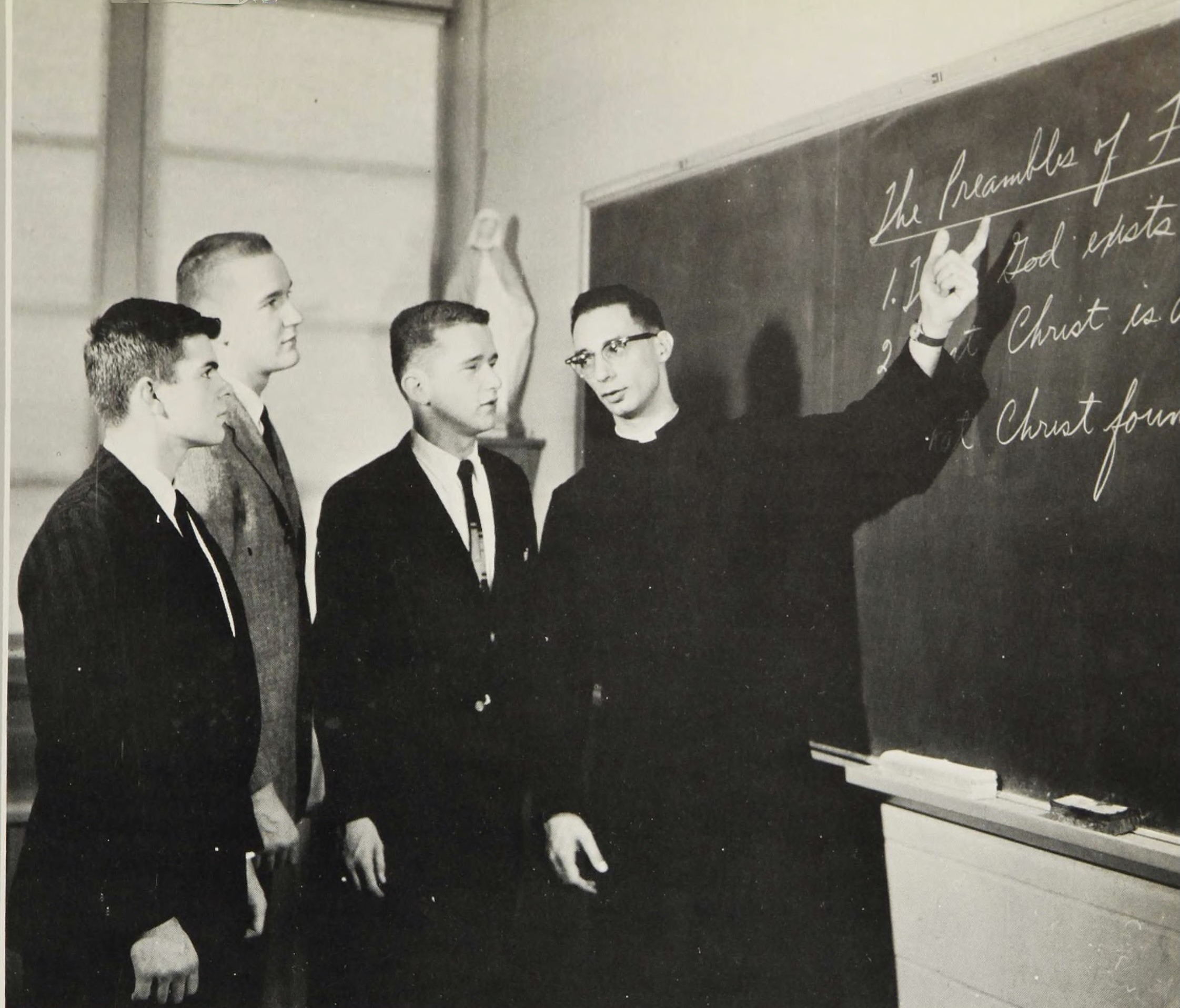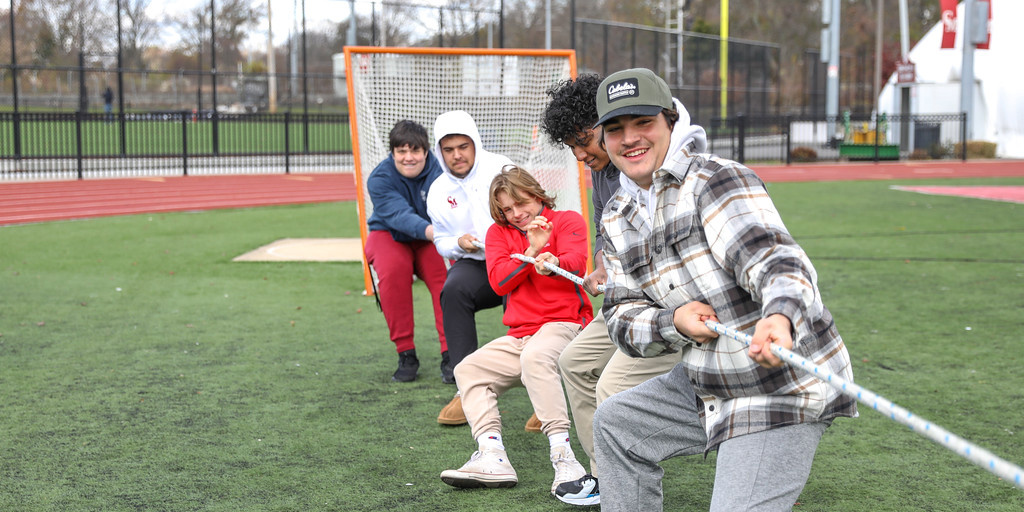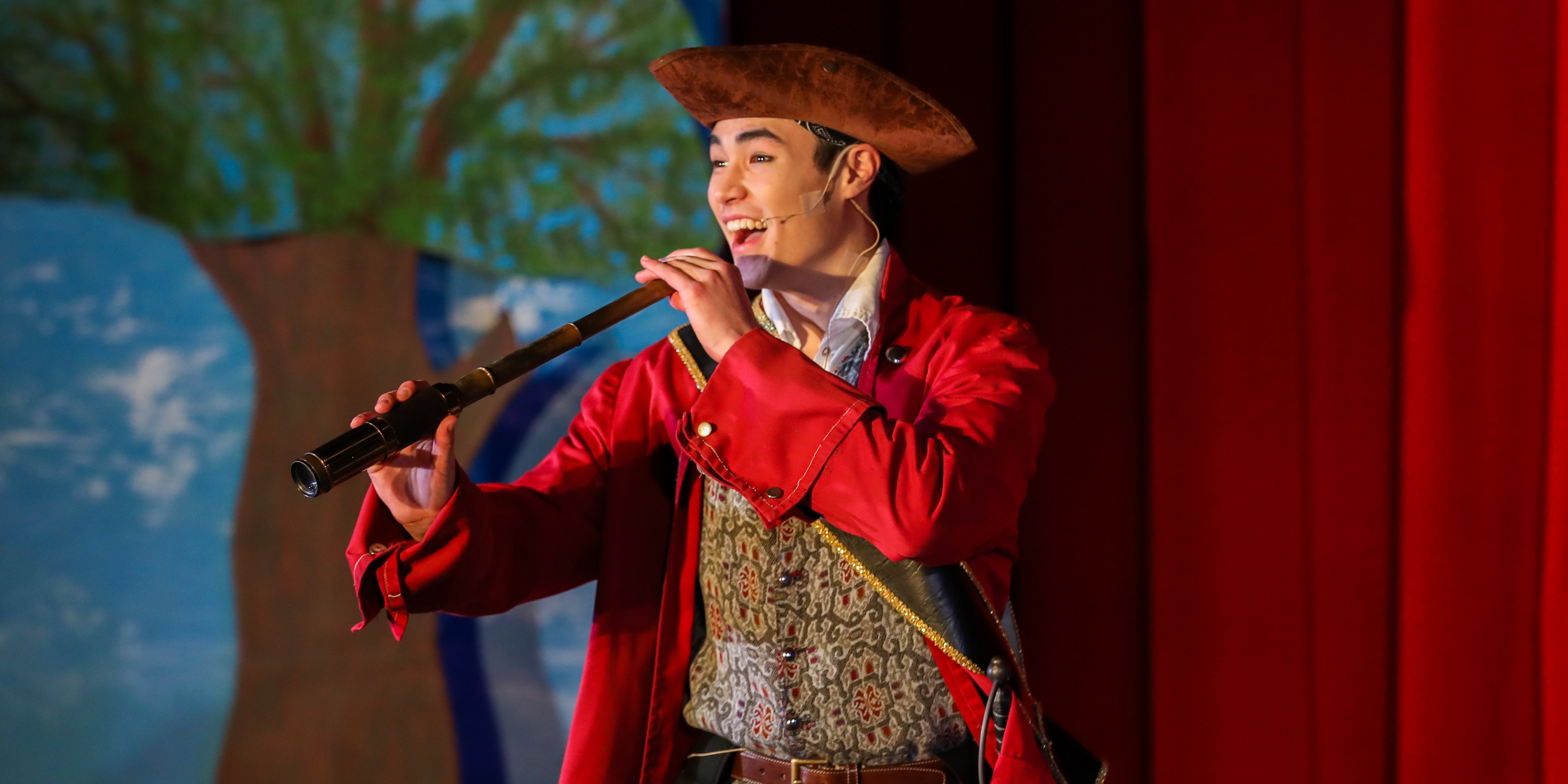With Our Hands We Learn
Gone are the days of assembly line education at CM. Throughout Catholic Memorial’s West Roxbury campus, the curriculum is aiming not at the traditional, but at the innovative. Donahue Hall is home to a design and engineering studio where middle school students experiment and explore with creative, hands-on projects.
Across the street, the Yawkey Center for Integrated and Applied Learning features classrooms with long, mobile desks, Smart TVs, and brightly painted walls to engender an atmosphere of creativity. At the heart of CM, the chapel and Campus Ministry are filled with student-made, hand-crafted care packages that will soon be on their way to help Boston’s homeless.
“Knight Based Learning,” says Principal Andrew O’Brien, “puts learning in the hands of the students.” So, with their hands, CM students design, build, strategize, and engage with their education.
Donahue Hall’s head of Design & Engineering, Mark Evans describes children’s creativity as “unbridled enthusiasm.” “Once [students] realize the privileges of freedom of movement, freedom of activity, all within safety protocols,” says Evans, “they start to express themselves a bit more in who they want to be.” CM’s approach to education blends academic disciplines, creating a fusion of arts, STEM, and critical thinking. Theology students build mazes to explore morality, biology students design and experiment with cardboard bird beaks, and Evans’ students build and race toy cars to understand turbo dynamics while learning to safely use tools.
“I think this class is a nice break in the boys’ day,” continues Evans, “that allows their brains to tune into a different channel. It subverts their expectations of what learning can look like.”
Students in Evans’ class feel empowered when they realize their grade is not affected by making mistakes. Instead, they find encouragement to try new things. But does the impact of KBL negate the need for traditional learning? The answer is not so obvious.
“Rigid, standard classrooms have their place,” notes Evans, “boys at this age respond well to structure, to instruction, to safety rails… but then project-based learning allows them to exercise all the other aspects of their brain—I wouldn’t want to do one without the other. One’s the theory, the other is the application.”
Comparing the two classroom styles at CM, Andrew O’Brien notes that “a traditional, teacher-centered classroom can sometimes be a passive experience for students. We’re trying to make the students very active in their learning. We do that by making the content relevant to their lives and giving them control over the experience.”
CM high school students studying in the Yawkey Center may cross paths with Mr. Alex Hajdukiewicz, whose Imagination Studio classroom is filled with motherboards, CPU chips, wires, wheels, lights, and tools. Hajdukiewicz teaches a robotics elective and, from his fourth-year teacher perspective, “Knight Based Learning focuses on kids’ exploration rather than ‘here’s the knowledge, absorb it.’ It’s fun to walk into this kind of classroom because you don’t know what’s going to happen.”
For Hajdukiewicz, robotics is about guiding students to work through failure and to create solutions on their own and with their peers. In a simulation of a Mars Rover robot, groups of students are tasked with creating a robot that would not break when ‘landing on Mars,’ or, falling from a desk. Some groups create parachutes, others create landing pads, yet most robots crash.
“It expands their creativity,” he smiles, “they start to learn that there isn’t one way to do it, there’s a thousand ways and no way is better than another. They all try to solve a difficult problem and most of them fail. At the end of every class, kids get to see what their peers are doing. They’ll say, ‘I really like that, I should have done something like that.’ They start to realize that all of the solutions together work better than each solution individually.”
Recounting his students’ successes, Hajdukiewicz continues that he “could give two weeks’ worth of lectures, have them label a diagram…they would know technical terms, they would comprehend writing about robots, but they wouldn’t understand how a robot moves, what it actually does. If I gave them just a lecture and none of the hands-on pieces, they’re missing probably the biggest aspect of the class: learning to adapt through failure.”
CM’s educators are in unanimous agreement that hands-on learning is essential for student growth and success in the twenty-first century. It would seem that KBL is not simply a set of tools to boost GPAs, but an unveiling of a way of learning that transcends the classroom. CM’s Director of Campus Ministry, Michael Dermody '07 believes that hands-on learning is perfectly exemplified in a Catholic education through service to a greater community.
“When we think about a science classroom…you take what you learn from that lecture and you put it into action through the lab,” he notes, “for us in Campus Ministry, we look at everything the boys learn in their theology classrooms, then put it into action through a variety of programs, most notably through service.”
“Theology can speak so much about how we can live a life like Christ,” adds Dermody. “It’s one thing to learn what that is, it’s another to then go put it into practice.” In the spirit of living like Christ, CM students prepare hospitality care packages for Boston’s homeless. The packages contain a variety of toiletries, non-perishable food items, and clothing. In each package, students include a hand-written note before being donated through a program with St. Francis House. Perhaps the carpenter from Galilee would be proud to see young people learning, exploring, and serving with their hands?
“As an alum of CM,” explains Dermody, “and as someone who has worked here now for eight years, I have seen that my students learn best when they are engaged in things that are, not only real-world-relevant, but that are more hands-on and allows for more realistic critical thinking than just reading a textbook.” Taking a reflective breath, Mr. Dermody continues, “Everything we do at CM is seeking to educate the boys so that they can grow, learn, and mature as young men. I think service has such a transformative impact on them because it
Across the street, the Yawkey Center for Integrated and Applied Learning features classrooms with long, mobile desks, Smart TVs, and brightly painted walls to engender an atmosphere of creativity. At the heart of CM, the chapel and Campus Ministry are filled with student-made, hand-crafted care packages that will soon be on their way to help Boston’s homeless.
“Knight Based Learning,” says Principal Andrew O’Brien, “puts learning in the hands of the students.” So, with their hands, CM students design, build, strategize, and engage with their education.
Donahue Hall’s head of Design & Engineering, Mark Evans describes children’s creativity as “unbridled enthusiasm.” “Once [students] realize the privileges of freedom of movement, freedom of activity, all within safety protocols,” says Evans, “they start to express themselves a bit more in who they want to be.” CM’s approach to education blends academic disciplines, creating a fusion of arts, STEM, and critical thinking. Theology students build mazes to explore morality, biology students design and experiment with cardboard bird beaks, and Evans’ students build and race toy cars to understand turbo dynamics while learning to safely use tools.
“I think this class is a nice break in the boys’ day,” continues Evans, “that allows their brains to tune into a different channel. It subverts their expectations of what learning can look like.”
Students in Evans’ class feel empowered when they realize their grade is not affected by making mistakes. Instead, they find encouragement to try new things. But does the impact of KBL negate the need for traditional learning? The answer is not so obvious.
“Rigid, standard classrooms have their place,” notes Evans, “boys at this age respond well to structure, to instruction, to safety rails… but then project-based learning allows them to exercise all the other aspects of their brain—I wouldn’t want to do one without the other. One’s the theory, the other is the application.”
Comparing the two classroom styles at CM, Andrew O’Brien notes that “a traditional, teacher-centered classroom can sometimes be a passive experience for students. We’re trying to make the students very active in their learning. We do that by making the content relevant to their lives and giving them control over the experience.”
CM high school students studying in the Yawkey Center may cross paths with Mr. Alex Hajdukiewicz, whose Imagination Studio classroom is filled with motherboards, CPU chips, wires, wheels, lights, and tools. Hajdukiewicz teaches a robotics elective and, from his fourth-year teacher perspective, “Knight Based Learning focuses on kids’ exploration rather than ‘here’s the knowledge, absorb it.’ It’s fun to walk into this kind of classroom because you don’t know what’s going to happen.”
For Hajdukiewicz, robotics is about guiding students to work through failure and to create solutions on their own and with their peers. In a simulation of a Mars Rover robot, groups of students are tasked with creating a robot that would not break when ‘landing on Mars,’ or, falling from a desk. Some groups create parachutes, others create landing pads, yet most robots crash.
“It expands their creativity,” he smiles, “they start to learn that there isn’t one way to do it, there’s a thousand ways and no way is better than another. They all try to solve a difficult problem and most of them fail. At the end of every class, kids get to see what their peers are doing. They’ll say, ‘I really like that, I should have done something like that.’ They start to realize that all of the solutions together work better than each solution individually.”
Recounting his students’ successes, Hajdukiewicz continues that he “could give two weeks’ worth of lectures, have them label a diagram…they would know technical terms, they would comprehend writing about robots, but they wouldn’t understand how a robot moves, what it actually does. If I gave them just a lecture and none of the hands-on pieces, they’re missing probably the biggest aspect of the class: learning to adapt through failure.”
CM’s educators are in unanimous agreement that hands-on learning is essential for student growth and success in the twenty-first century. It would seem that KBL is not simply a set of tools to boost GPAs, but an unveiling of a way of learning that transcends the classroom. CM’s Director of Campus Ministry, Michael Dermody '07 believes that hands-on learning is perfectly exemplified in a Catholic education through service to a greater community.
“When we think about a science classroom…you take what you learn from that lecture and you put it into action through the lab,” he notes, “for us in Campus Ministry, we look at everything the boys learn in their theology classrooms, then put it into action through a variety of programs, most notably through service.”
“Theology can speak so much about how we can live a life like Christ,” adds Dermody. “It’s one thing to learn what that is, it’s another to then go put it into practice.” In the spirit of living like Christ, CM students prepare hospitality care packages for Boston’s homeless. The packages contain a variety of toiletries, non-perishable food items, and clothing. In each package, students include a hand-written note before being donated through a program with St. Francis House. Perhaps the carpenter from Galilee would be proud to see young people learning, exploring, and serving with their hands?
“As an alum of CM,” explains Dermody, “and as someone who has worked here now for eight years, I have seen that my students learn best when they are engaged in things that are, not only real-world-relevant, but that are more hands-on and allows for more realistic critical thinking than just reading a textbook.” Taking a reflective breath, Mr. Dermody continues, “Everything we do at CM is seeking to educate the boys so that they can grow, learn, and mature as young men. I think service has such a transformative impact on them because it
gives them opportunities to put themselves in situations outside of what they’re used to… to interact with people who work in or who need service.”
Principal O’Brien recalls that “the age-old question heard in a classroom is, ‘why are we learning this?’ By making content relevant to students’ lives, they don’t have to ask that question because it’s right there in front of them.”
“I have been so often impressed by whatever solutions the boys have come up with,” smiles Evans. “It was more creative or more inventive than I could have ever presented. Instead of me saying ‘do this,’ they come to me and say, ‘Mr. Evans, this is how we got it done.’”
“KBL has helped me structure lessons that will engage the kids and have them working – not because I told them to, but because they want to,” concludes Hajdukiewicz.
While the structured, standard classroom has its place at CM, the hands-on approach to learning is yielding impressive results from students and staff. Many boys are primarily tactile, kinesthetic learners. Movement, building, gameplay, and problem-solving all comprise their comprehension landscape. Knight Based Learning blends sensation with innovation, producing meaningful, goal-oriented outcomes that keep students engaged and retaining the lessons of the day.
Principal O’Brien recalls that “the age-old question heard in a classroom is, ‘why are we learning this?’ By making content relevant to students’ lives, they don’t have to ask that question because it’s right there in front of them.”
“I have been so often impressed by whatever solutions the boys have come up with,” smiles Evans. “It was more creative or more inventive than I could have ever presented. Instead of me saying ‘do this,’ they come to me and say, ‘Mr. Evans, this is how we got it done.’”
“KBL has helped me structure lessons that will engage the kids and have them working – not because I told them to, but because they want to,” concludes Hajdukiewicz.
While the structured, standard classroom has its place at CM, the hands-on approach to learning is yielding impressive results from students and staff. Many boys are primarily tactile, kinesthetic learners. Movement, building, gameplay, and problem-solving all comprise their comprehension landscape. Knight Based Learning blends sensation with innovation, producing meaningful, goal-oriented outcomes that keep students engaged and retaining the lessons of the day.



